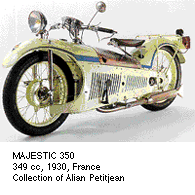|
NEW WORLD ORDERS: [1930-1944]
The free-spirited character of innovation and experimentation that
flourished during the 1920s underwent a sea change in the next decade. Whereas the
machine aesthetic of the '20s was realized through a prevailing tendency toward abstraction,
based on a reductive, geometric vocabulary and a utopian political agenda, the ethos
of machine culture in the 1930s assumed an altogether different scale and demeanor.
Ushered in by a wave of conservative, even totalitarian, political ideology that
overswept Europe, the cultural landscape shifted toward social realism, a state-controlled
ideology of popular, classically inspired art and architecture that celebrated national
identity through grandiose themes in works on a commensurate scale.
Ironically, social realism incarnated many of the principles and ideals of the prior
decade: a belief in technology's potential to transform society and a desire to communicate
through a universal form of visual expression. In Germany, the Weimar Republic's
short-lived experiment in parliamentary democracy was buried under the weight of
high inflation and unemployment. Demoralized by the loss of World War I, Germany
had been further humiliated by the Treaty of Versailles, which exacted a high price
from the country in the form of reparations, demobilization of its armed forces,
and concessions on territorial claims. Thus, by the time Adolf Hitler became chancellor
in 1933, Germany was ripe for transformation.
The irony of this era is that communism, the archenemy of fascism, embraced many
of its ideals. Steeped in the same cults of personality and celebrations of national
identity, Stalin launched Soviet Russia into a new era of bold industrialization
that was to be achieved through a series of harshly ambitious Five Year Plans. As
in Italy and Germany, the ideology of modernization was propagated through large-scale
planning and classical ideals of physical strength, continuity, order, and stability.
Monuments were an inevitable outgrowth of these ideologies, and were constructed
with fervor.
The legacy of these ideological dictatorships is now a matter of history. Having
placed their own houses in order, or in some cases due to an inability to do so,
they set out to change the rest of the world, each seeking to establish a new paradigm
based on its own political philosophy. Technologies developed for social transformation
became weapons of destruction. Indian, Zuendapp and Harley-Davidson were amongst
the many motorcycle manufacturers that saw service during the war; and many more,
particularly British manufacturers, fell victim to the postwar financial crisis in
Europe, with its reverberations reaching into the 1950s.
|
